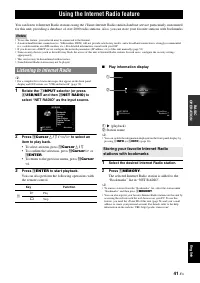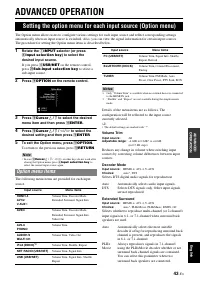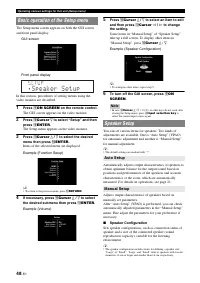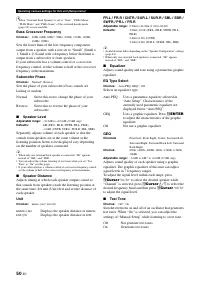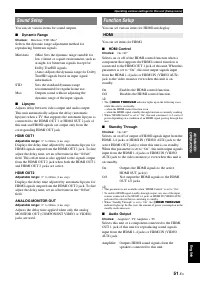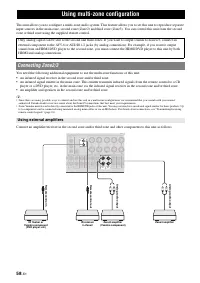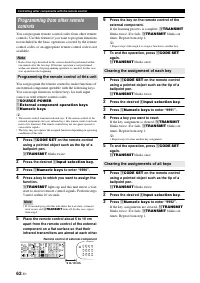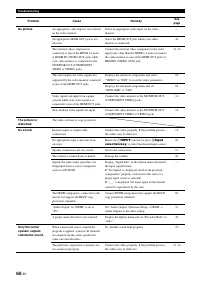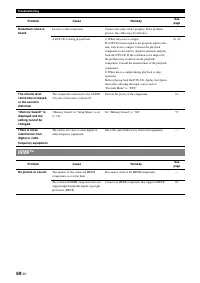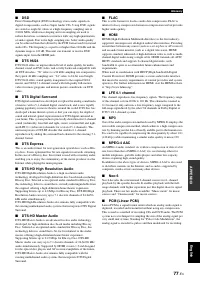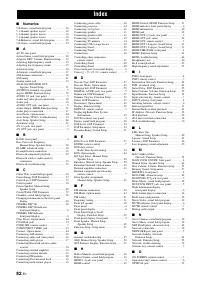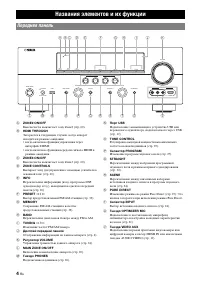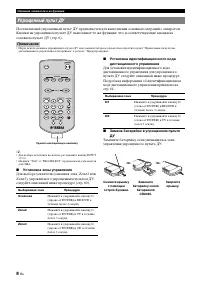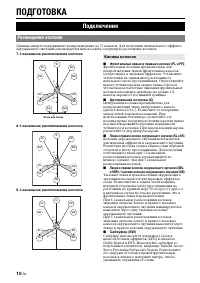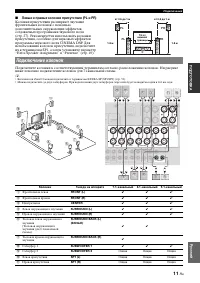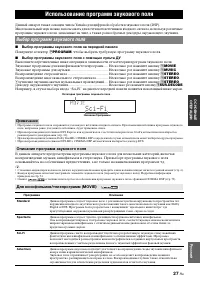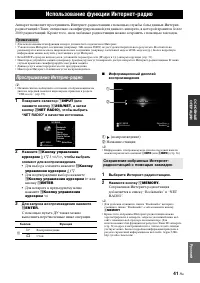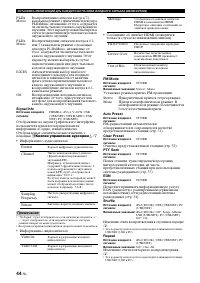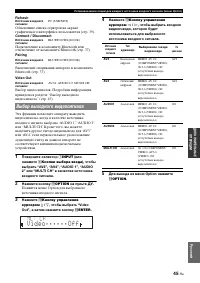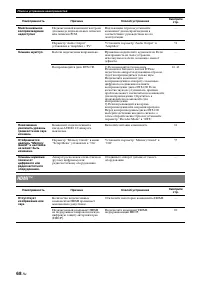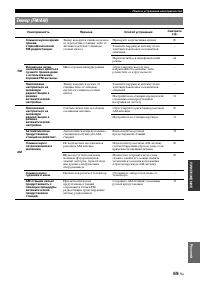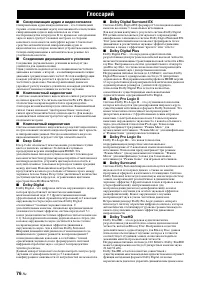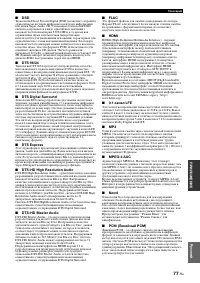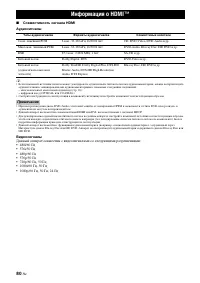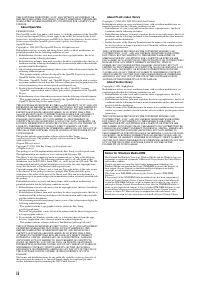Усилители Yamaha RX-V2065 - инструкция пользователя по применению, эксплуатации и установке на русском языке. Мы надеемся, она поможет вам решить возникшие у вас вопросы при эксплуатации техники.
Если остались вопросы, задайте их в комментариях после инструкции.
"Загружаем инструкцию", означает, что нужно подождать пока файл загрузится и можно будет его читать онлайн. Некоторые инструкции очень большие и время их появления зависит от вашей скорости интернета.

76
En
■
Audio and video synchronization (lip sync)
Lip sync, an abbreviation for lip synchronization, is a technical term
that involves both a problem and a capability of maintaining audio and
video signals synchronized during post-production and transmission.
Whereas the audio and video latency requires complex end-user
adjustments, HDMI version 1.3 incorporates an automatic audio and
video syncing capability that allows devices to perform this
synchronization automatically and accurately without user interaction.
■
Bi-amplification connection
A bi-amplification connection uses two amplifiers for a speaker.
One amplifier is connected to the woofer section of a loudspeaker
while the other is connected to the combined mid and tweeter section.
With this arrangement each amplifier operates over a restricted
frequency range. This restricted range presents each amplifier with a
much simpler job and each amplifier is less likely to influence the
sound in some way.
■
Component video signal
With the component video signal system, the video signal is separated
into the Y signal for the luminance and the P
B
and P
R
signals for the
chrominance. Color can be reproduced more faithfully with this
system because each of these signals is independent. The component
signal is also called the “color difference signal” because the
luminance signal is subtracted from the color signal. A monitor with
component input jacks is required in order to output component
signals.
■
Composite video signal
With the composite video signal system, the video signal is composed
of three basic elements of a video picture: color, brightness and
synchronization data. A composite video jack on a video component
transmits these three elements combined.
■
Deep Color
Deep Color refers to the use of various color depths in displays, up
from the 24-bit depths in previous versions of the HDMI specification.
This extra bit depth allows HDTVs and other displays go from
millions of colors to billions of colors and eliminate on-screen color
banding for smooth tonal transitions and subtle gradations between
colors. The increased contrast ratio can represent many times more
shades of gray between black and white. Also Deep Color increases
the number of available colors within the boundaries defined by the
RGB or YCbCr color space.
■
Dolby Digital
Dolby Digital is a digital surround sound system that gives you
completely independent multi-channel audio. With 3 front channels
(front L/R and center), and 2 surround stereo channels, Dolby Digital
provides 5 full-range audio channels. With an additional channel
especially for bass effects, called LFE (Low Frequency Effect), the
system has a total of 5.1-channels (LFE is counted as 0.1 channel). By
using 2-channel stereo for the surround speakers, more accurate
moving sound effects and surround sound environment are possible
than with Dolby Surround. The wide dynamic range from maximum
to minimum volume reproduced by the 5 full-range channels and the
precise sound orientation generated using digital sound processing
provide listeners with unprecedented excitement and realism.
With this unit, any sound environment from monaural up to a 5.1-
channel configuration can be freely selected for your enjoyment.
■
Dolby Digital Surround EX
Dolby Digital EX creates 6 full-bandwidth output channels from 5.1-
channel sources.
For the best results, Dolby Digital EX should be used with movie
sound tracks recorded with Dolby Digital Surround EX. With this
additional channel, you can experience more dynamic and realistic
moving sound especially with scenes with “fly-over” and “fly-
around” effects.
■
Dolby Digital Plus
Dolby Digital Plus is an advanced audio technology developed for
high-definition programming and media including HD broadcasts,
and Blu-ray Disc. Selected as an optional audio standard for Blu-ray
Disc, this technology delivers multichannel sound with discrete
channel output. Supporting bitrates up to 6.0 Mbps, Dolby Digital
Plus can carry up to 7.1 discreet audio channels simultaneously.
Supported by HDMI version 1.3 and designed for the optical disc
players and AV receivers/amplifiers of the future, Dolby Digital Plus
also remains fully compatible with the existing multichannel audio
systems that incorporate Dolby Digital.
■
Dolby Pro Logic II
Dolby Pro Logic II is an improved technique used to decode vast
numbers of existing Dolby Surround sources. This new technology
enables a discrete 5-channel playback with 2 front left and right
channels, 1 center channel, and 2 surround left and right channels
instead of only 1 surround channel for conventional Pro Logic
technology. There are three modes available: “Music mode” for music
sources, “Movie mode” for movie sources and “Game mode” for
game sources.
■
Dolby Pro Logic IIx
Dolby Pro Logic IIx is a new technology enabling discrete
multichannel playback from 2-channel or multi-channel sources.
There are three modes available: “Music mode” for music sources,
“Movie mode” for movie sources (for 2-channel sources only) and
“Game mode” for game sources.
■
Dolby Surround
Dolby Surround is widely used with nearly all video tapes and laser
discs, and in many TV and cable broadcasts as well. Dolby Surround
uses a 4-channel analog recording system to reproduce realistic and
dynamic sound effects: 2 front left and right channels (stereo), a
center channel for dialog (monaural), and a surround channel for
special sound effects (monaural). The surround channel reproduces
sound within a narrow frequency range. The Dolby Pro Logic decoder
built into this unit employs a digital signal processing system that
automatically stabilizes the volume on each channel to enhance
moving sound effects and directionality.
■
Dolby TrueHD
Dolby TrueHD is an advanced lossless audio technology developed
for high-definition disc-based media including Blu-ray Disc. Selected
as an optional audio standard for Blu-ray Disc, this technology
delivers sound that is bit-for-bit identical to the studio master, offering
a high-definition home theater experience.
Supporting bitrates up to 18.0 Mbps, Dolby TrueHD can carry up to 8
discrete channels of 24-bit/96 kHz audio simultaneously.
Dolby TrueHD also remains fully compatible with the existing
multichannel audio systems and retains the metadata capability of
Dolby Digital, allowing dialog normalization and dynamic range
control.
Glossary
Содержание
- 87 ВВЕДЕ; СОДЕРЖАНИЕ; ВВЕДЕНИЕ
- 88 Описание
- 89 АЯ; Bluetooth; Убедитесь в наличии всех перечисленных ниже деталей.; О данном руководстве; Поставляемые принадлежности
- 90 Названия элементов и их функции; Передняя панель
- 91 Задняя панель
- 92 Примечание; Установка батареек; Снимите крышку отделения для батареек.; Зона действия; Дисплей передней панели; Пульт ДУ
- 94 Установка зоны управления; Упрощенный пульт ДУ
- 95 Краткое руководство пользователя; Шаг 1: Подготовьте компоненты к
- 96 ПОДГОТОВКА; Фронтальные левые и правые колонки (FL и FR); Подключения; Размещение колонок; Каналы колонок
- 97 Подключение колонок
- 98 Подключение кабелей колонок; Предупреждение
- 99 Информация о гнездах и штекерах кабелей
- 100 Подключение ТВ-экрана или проектора
- 101 Вывод звука телевизора через аппарат
- 102 Подключение других компонентов
- 103 Поток аудиосигналов; Примечания; Информация о выходных аудио/видеогнездах
- 104 Подключение внешнего усилителя; Передача/прием сигналов дистанционного управления
- 105 Подключение к сети; Использование гнезд VIDEO AUX
- 106 Подключение силового кабеля
- 107 ДОПОЛНИТЕЛЬН; наушники отсоединены от аппарата; Оптимизация настройки колонок для комнаты для; Использование Auto Setup
- 109 Повтор процедуры “Auto Setup”.
- 110 ОСНОВНЫЕ ОПЕРАЦИИ; Воспроизведение; Основная процедура; Использование функции SCENE; Выбор SCENE
- 111 Приглушение выводимого звука
- 112 Вставьте наушники в гнездо; на; Несколько раз нажмите кнопку; Использование наушников
- 113 Поверните селектор; Выбор программы звукового поля с помощью пульта ДУ; Использование программ звукового поля; Выбор программ звукового поля; Описание программ звукового поля
- 115 Для воспроизведения многоканального стереозвука (STEREO)
- 117 Настройка радиопрограмм диапазона FM/AM
- 118 Удаление предустановленных радиостанций
- 119 Настройка на систему радиоданных; Наименование программы, частота
- 121 Использование iPodTM; Управление iPodTM
- 123 Использование компонентов BluetoothTM
- 124 Использование запоминающих устройств USB
- 125 Использование компьютерных серверов
- 127 Использование функции Интернет-радио; Прослушивание Интерне-радио
- 128 чтобы установить временной промежуток.; Другие функции; Выбор гнезда HDMI OUT; Использование таймера сна
- 129 ДОПОЛНИТЕЛЬНЫЕ ОПЕРАЦИИ; Пункты меню Option
- 130 Кнопки управления курсором
- 131 Обновление списка серверов на экране; Выбор выходного видеосигнала
- 132 Управление различными настройками аппарата (меню Setup)
- 134 Экран графического интерфейса пользователя; Основные операции меню Setup
- 136 Кнопку управления
- 138 Volume
- 140 Основные параметры CINEMA DSP
- 142 Reverb Time
- 143 Параметры декодера
- 144 Приемник инфракрасных сигналов во второй и/или третьей зоне.; Использование многозонной конфигурации; Использование внешних усилителей
- 145 Использование внутренних усилителей аппарата; Важное предупреждение о безопасности
- 146 выбор источника входного сигнала; Если была нажата кнопка; Операции в режиме управления Zone2/3
- 147 Управление другими компонентами с помощью пульта ДУ; Установка кодов ДУ
- 148 Программирование с других пультов ДУ
- 149 Дополнительные настройки
- 150 Нажмите кнопку; Установка идентификатора пульта ДУ
- 151 ÏÎÄÃÎÒÎÂÊÀ; ПРИЛОЖЕНИЕ; Поиск и устранение неисправностей; Неисправности общего характера
- 158 USB и сеть
- 160 Перед выполнением процедуры Auto Setup
- 161 После Auto Setup
- 162 Глоссарий
- 164 Частота выборки и глубина квантования
- 165 Информация о программах звукового поля
- 166 Совместимость сигнала HDMI; Видеосигналы; Информация о HDMITM
- 167 Технические характеристики
- 168 Индекс
- 169 PRE










































